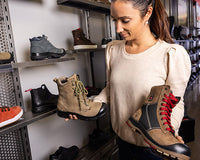Many safety shoes on the market claim to be slip-resistant. We understand that they resist slipping, but how do we define the level of resistance? That's the question we'll try to explain in this blog post.
In Canada, the CSA Z195 standard includes a series of measures to ensure that footwear protects the worker. These measures include toe protection, sole perforation protection, metatarsal protection and protection against electric shock. Although this variable must be measured for all footwear with an identified slip-resistant sole, CSA Standard Z195-14 does not set standard results.
Friction coefficient
Slip resistance is defined as the amount of resistance exerted by the sole as it moves over the walking surface. This resistance is measured using the coefficient of friction (COF): the ratio between the maximum friction force applied by the sole and the force pushing the sole over the surface.
The higher the number, the greater the slip resistance. Footwear manufacturers use ISO 13287 to measure COF, as specified in the CSA standard. Tests will be carried out on a steel floor (wet) and on ceramic tiles (dry and wet). The results of this test will be added to the footwear label as required by CSA Z195.

Test limitations
However, care must be taken with this scale. The tests are only carried out on two types of surface. Your job involves floors that will be different from laboratory tests, and the soles will be in contact with a variety of liquids (water, oil, ice, etc.). Temperature will also have a major impact on a sole's slip resistance. That's why it's important to find the right insole for your working environment.
Our in-store advisors are trained to help you find the ideal insole. They'll be happy to help you find the right shoe for your needs!



